Recording, conserving and promoting the landscape and rocks of the Sheffield region
Building Stones
As well as the brief notes below, case studies of the uses of individual units of sedimentary rocks in the region are included as pdf files for you to download. (Click on the links above.)
Three historic sources of information about quarrying in the region have also been summarised as pdf files.
For a link to the original references see below.
Graham Loft, of the British Geological Survey, has produced a more recent list which is available online.
We have tried to locate many of these old quarries, and have given tentative grid references for some, based on Ordnance Survey maps dating from the 1850s onwards. We have also endeavoured to provide the current names for the geological Formations which were being worked. There are some inconsistencies in nomenclature, notably with Farey's records of 1811, and we would welcome any additional information which readers may be able to supply.
The 1897 list of quarries in our region has been transcribed from the national list of Mines and Quarries held at the Library of the British Geological Survey. It is included here as part of our developing research into the local history of quarrying. Note that the boundaries of Derbyshire have changed since 1897. Entries in this list are colour coded to show current administrative boundaries - Barnsley MBC pink, Doncaster MBC orange, Rotherham MBC blue, Sheffield MBC grey. Some sites in Derbyshire are outside the remit of the Sheffield Area Geology Trust and are left uncoloured.
Many of the buildings of Sheffield and its region are constructed from sedimentary rocks which crop out within the region. These include:
Permian
Cadeby Formation
The dolomitic limestones (magnesian limestones or dolostones) of this formation crop out in a narrow north to south strip that extends along the eastern margin of the west Yorkshire area, forming a low topographical ridge marginal to the Vale of York. They have been quarried and used extensively for building stone in many towns and villages, on and adjacent to, their outcrop, e.g. churches and houses at Conisborough (also the prominent castle), Anston, Maltby, Doncaster, High Melton, Cadeby, Hooton Pagnell, Sherburn-in-Elmet, Ledsham, Clifford, Boston Spa, Wetherby etc.
Cadeby Formation limestones were used in the construction of Liverpool Lime Street Station and in various warehouse and other buildings in Manchester and Sheffield. Quarries at North Anston provided the stone for the Houses of Parliament, transported to the coast via the Chesterfield Canal.
Fine-grained limestone from quarries near Anston and Kiveton Park, operated by James Turner & Son, was used in the construction of several important buildings in London, including the Houses of Parliament, the Geological Museum, New Hall (Lincoln's Inn), the Record Office (Fetter Lane), the Ordnance Office (Pall Mall), the flying buttresses at Westminster Abbey, and several other buildings.
Ref: Practical Masonry, by William Purchase, 1905.
Carboniferous - Pennine Coal Measures Group
A number of sandstones that are developed within the Coal Measures succession have been worked for local building stone. The sandstones are generally finer - and more uniform than those from the Millstone Grit Group.
Upper Coal Measures Formation
In the uppermost part of the Coal Measures succession, the best known sandstones are the Ackworth, Dalton, Wickersley and Ravenfield rocks. At Ackworth the buildings of the village and local farms are all constructed of pale yellow-brown, (when weathered) fine-grained sandstone from the Ackworth Rock. The Dalton Rock (aka Brierley Rock) was worked at Dalton, Brierley and Great Houghton for building use in the nearby villages. The quarries in the Wickersley Rock, Rotherham were perhaps more noted for their grindstone production for the Sheffield cutlery industry, but also produced the building stone used in the older houses and walls at Wickersley.St. Aidan's Church, Wickersley
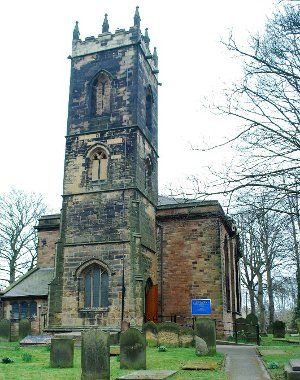
Middle Coal Measures Formation
Mexborough Rock
The Mexborough Rock, characterised by its distinctive purple-red colouration, was quarried and used for building extensively at and around Darfield, Mexborough, Denaby, Hooton Roberts, Canklow. The local church and houses at Hooton Roberts show the typical pale-purple coloration of this sandstone (Rotherham Red), much of it produced from nearby quarries, of which one, Harris Quarry near Ulley, is still active today. The sandstone was also used locally in houses, schools and other buildings around Rotherham and Masborough (Hunt 1858).
Woolley Edge Rock
The Woolley Edge Rock was quarried at Woolley Edge and at other quarries in the Barnsley area. St. Thomas' Church at Worsborough sits on the outcrop of the Woolley Edge Rock, with a former quarry adjacent.
Oaks Rock
The Oaks Rock has been quarried at Barnsley and used locally.
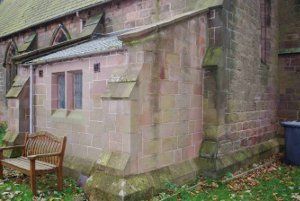
Ulley Church - extension of the early C21 in Mexborough Rock from Harris Quarry
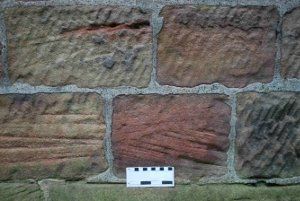
Ulley Church - weathering in Mexborough Rock, built c.1852 (information from John Harris)
Lower Coal measures Formation
Crawshaw Sandstone
The Crawshaw Sandstone was extensively quarried near Crookes in the west of Sheffield for building purposes. The buff coloured, medium-grained sandstone is a familiar feature of many Sheffield buildings, notably a high proportion of the schools built by the Sheffield School Board between 1870 and the First World War.
Loxley Edge Rock
The Loxley Edge Rock varies in thickness and character along its outcrop and the very coarse sandstone found on Loxley and Wadsley Commons features in a number of prominent buildings, such as the former Royal Infirmary. Further south, in the Greystones area, it is finer-grained, less massive and more flaggy, and was only worked for local building stone, where it is a common feature of garden walls etc.
Green Moor Rock
The Green Moor Rock (or Brincliffe Edge Rock) and Grenoside Sandstone were particularly significant sources of stone for highway engineering, such as paving stone, kerbs and gutters. Much stone was regularly exported by water transport from the quarries at Greenmoor itself to London, (where it is referred to as "York Stone"), as well as being widely used within the region. Stone from Brincliffe Edge and Psalter Lane was used in local buildings as well as in gravestones and grindstones. These units are mostly fine-grained, uniform sandstones.
Silkstone Rock
Silkstone Rock - used for supporting the railway cutting on the north side of Sheffield Station (from where it was excavated). Many quarries in the Silkstone Rock, such as that at Arbourthorne, supplied readily trimmed, fine-grained sandstone for local use. The Shrewsbury "Hospital" was built with rock from Claywood Quarry just across the road. Silkstone Rock was also favoured by scythe makers for sharpening stones. Bramley Moor Quarry near Eckington was probably the only operation of any scale, with Staniforth's sickle manufactory being located at Troway nearby.
Parkgate Rock
The Parkgate Rock was worked in the Grimesthorpe area of Sheffield and the Park Hill Quarries supplied paving, channel & kerb stones for Sheffield's streets throughout much of the 19th century.
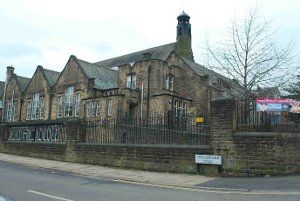
Greystones School, built 1904
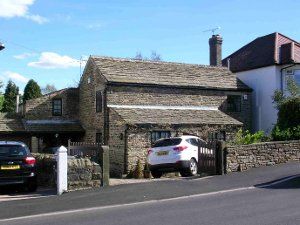
House on Haugh Lane with local sandstone and stone slates, probably 18th Century
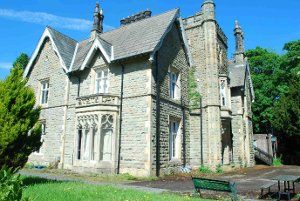
Brincliffe Towers - former nursing home, built of Greenmoor Rock from Brincliffe Edge, with a slate roof. Built around 1860.
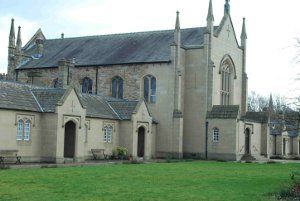
The chapel at the Shrewsbury Almshouses, built in 1825 from Silkstone Rock, but partly re-faced in finer-grained sandstone in the 1990s.

Sandstone setts and kerbs - origin of stone uncertain
Millstone Grit Group
All the principal sandstone beds of the Millstone Grit Group have been extensively quarried.
Rough Rock
The Rough Rock is the most constant and uniform of all the Millstone Grit sandstones in South and West Yorkshire. The sandstones are generally coarse-grained and strongly cross-bedded in the south of the region, but less coarse in the Huddersfield area. The quarries in Rough Rock at Crosland Hill are regarded as the principal source of building stone for Huddersfield town and were used in major structures such as the Lockwood Viaduct (1846). Most recently in Sheffield, Rough Rock Stone was used to construct the sculptured planters placed in Tudor Square, which are supposed to represent giant seed pods. The sandstone pavings in the Peace Gardens are of Rough Rock "Rockingstone", shot-sawn to create a non-slip surface.
Within the Sheffield area the Rough Rock was quarried for building stone at Tapton Hill and Basset Brown Edge. "Stone slates" were worked at Brown Edge, near Ringinglow in the 19th Century. These are a local, thinly-bedded variety of this stone, capable of being split into thin sheets.
Chatsworth Grit (or Rivelin Grit)
The Chatsworth Grit has only a restricted outcrop to the west of Sheffield, nevertheless, a number of local quarries, notably in the Rivelin Valley, supplied this stone for many of Sheffield's sandstone buildings. The unit was also worked extensively at Burbage Rocks, Millstone Edge and Houndkirk Moor for millstones. Examples of prominent buildings probably constructed from Chatsworth Grit include the Gatehouses of the General Cemetery and the Botanical Gardens. It is a coarse, or very coarse sandstone with angular grains, and usually contains some feldspar among the quartz grains.
Ashover Grit
The Ashover Grit is extensively worked to the south of Sheffield and stone from Birchover, Stanton Moor and Stancliffe is being used in the city centre, e.g. in Orchard Square (1980s), Sheffield Law Courts (combined with pink Shap Granite) and for repair work on Sheffield Cathedral (note new pinnacles). It is mostly a medium-grained sandstone, with sub-angular grains.
Kinderscout Grit
The Kinderscout Grit is the oldest of the major Millstone Grit sandstone beds and forms the extensive and often inaccessible area of the Kinder Scout - Bleaklow moors. It tends to be a very coarse and hard sandstone, which makes it less useful as a building stone. One of the quarries which has worked the Kinderscout Grit since 1835, is at Stoke Hall, near Grindleford, where the stone is a more uniform, medium-grained sandstone which can be shaped in any direction, i.e. it is a 'freestone'. This quarry supplied the stone used to construct Sheffield's Town Hall, which was officially opened by Queen Victoria in 1897. An extension built with the same material was opened by the Prince of Wales in 1923. The sculptures and balustrades in the adjoining Peace Gardens were installed in the 1990s using matching stone from the same quarry, which is still operating.
Photos copyright: P. Kennett except where otherwise noted.
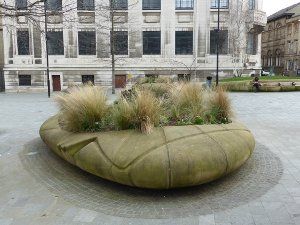
Tudor Square planter (Photo: J. Hunter)
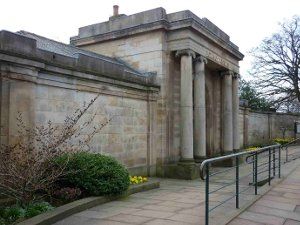
Gatehouse, Botanical Gardens, Clarkehouse Road entrance (Photo: A. Hunter)
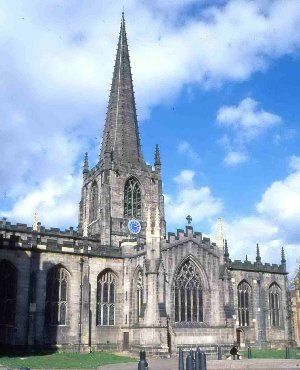
Sheffield Cathedral
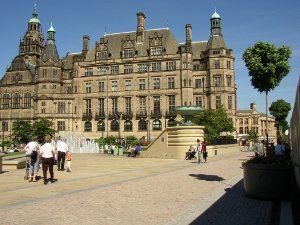
Sheffield Town Hall and Peace Gardens
